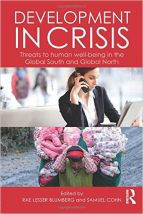Development in Crisis: Threats to human well-being in the Global South and Global North

Bringing together sociological and non-sociological development scholars, Development in Crisis presents an interdisciplinary dialogue on the challenges that face development today and potential sources of crisis in development in the future. Its chapters discuss a wide range of problems and solutions relating to crises in development, based on cases from Argentina to Southeast Asia. In essence, they highlight the importance of greater state capacity and gender-equal citizen empowerment.
Editors Blumberg and Cohn set the foundation for the book in Chapter 1 by introducing how development lives and dies. Here they identify the vulnerabilities and victims of development, and identify four choke points that could constrain future economic development. In brief, these “Four Great Constraints” are: limits to the state’s capacity to provide key growth infrastructure; limits to societal capacity to recover from exhausted product cycles; entrepreneurial stagnation linked to class inequality; and limits to economic/entrepreneurial activity linked to female economic disempowerment (page 5).
In Chapter 2, Fatton highlights the importance of state capacity by examining the plight of Haiti. Situating this failed and lone country in the “outer-periphery” zone of the world capitalist economy, Fatton explores the concept of the outer-periphery and unpicks why Haiti finds itself in this new zone (page 33).
Based on the belief that shrinking the state or cutting taxes does not provide compensating economic development, Cohn reviews the literature on taxes and employment in Chapter 3. Here he provides detailed analysis of the case for and against tax cuts and illustrates these with stories from America, Brazil and Morocco.
In Chapter 4, Kerbo analyses historical data of four Southeast Asian countries that are rooted in ancient civilisations: Cambodia, Laos, Vietnam and Thailand. He examines their traditions of government complexity, elite responsibility, and relative ethnic homogeneity, in order to determine why some authoritarian governments work for the long-term development of their nation while others are self-serving.
In Chapter 5, Schwartz unpicks his question “Does a post-scarcity world mean an end to development?” (page 84). He discusses his meaning of development and a post-scarcity world before considering the implications of reduced export growth for developing economies, which he illustrates with agricultural exports in the 19th century (page 95).
The impacts of gender discrimination and sex ratios on development are explored in Chapter 6. Here Weitzman identifies the underlying causes of household gender discrimination, as well as the practices of gender discrimination and their effect upon sex ratios. Furthermore she considers the unintended consequences of imbalanced sex ratios upon development.
In Chapter 7, based on the link between gender empowerment and sustainability, Scanlan presents a gender and development (GAD) study to explore the connections between women’s empowerment and the environment, and to identify how economic, political and social improvements in women’s lives can contribute to sustainability (page 116).
Chapter 8 continues to look at gender as Blumberg analyses the experiences of women in Afghanistan and Northern Uganda through the lens of two theories: the theory of gender stratification, and the theory or gender and development. Here she looks at the effects of economic (dis)empowerment for both women and wider society.
Turning to Zimbabwe in Chapter 9, Zukas studies its bipolar development: a development crisis on the one hand and women’s development activism initiated through women’s groups on the other.
In Chapter 10, vom Hau analyses social movement impact through a case study of indigenous land claims in Argentina and considers the developmental implications of such mobilization.
Shifting attention to North America, Handler presents an essay in Chapter 11 on the poor state of how development and global studies is taught in colleges and universities. He argues that students are not being taught about real development crises or the role rich nations play in them, and are thus ill equipped to offer solutions in practice (page 26).
Finally, to close in Chapter 12, Reynolds shares his story of involvement with the International Campaign to Ban Landmines (ICBL). Through this he discusses the relationship between landmines and sustainable development, and the role activism plays together with collaborative partnerships.
Book note prepared by Hannah Keren Lee
Search the Book notes database
Our Book notes database contains details and summaries of all the publications included in Book notes since 1993 - with details on how to obtain/download.
Use the search form above, or visit the Book notes landing page for more options and latest content.
For a searchable database for papers in Environment and Urbanization, go to http://eau.sagepub.com/

